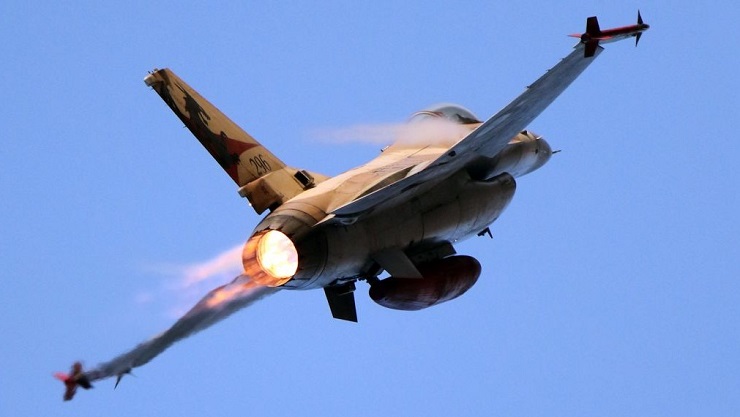Despite repeated statements at the UN by official Syrian authorities, Israel continues regular airstrikes against Syrian civilian targets, including provocative airstrikes when its fighter jets start hiding behind civilian aircraft.
In early September alone, Israeli Air Force fighter jets fired 24 missiles at targets inside Syria. The Syrian Air Defense Force destroyed 21 missiles thanks to Russian-made Buk-M2E and Pantsir-S1 systems. Before that, the Syrian Air Defense Force repulsed another Israeli attack in the skies over Damascus.
On October 8, six Israeli Air Force F-16 aircraft attacked, using 12 guided missiles, the T-4 airfield in the Syrian province of Homs, north of Al-Tanf. They carried out the attack from the Lebanese airspace after having crossed of state borders of Syria. The Syrian Air Defense Force destroyed eight Israeli missiles using the Russian-made Pantsir surface-to-air missile launcher system. The Israeli attack injured six Syrian soldiers guarding the civilian facility and damaged Syrian Arab Armed Forces equipment.
On October 13, during the night hours, four Israeli Air Force F-16 aircraft re-entered Syrian airspace near the US-occupied Al-Tanf zone in Homs province and, hiding behind civilian aircraft, which flew at that moment, carried out an airstrike on a phosphate processing plant near Palmyra. The Syrian army command decided not to use anti-aircraft systems to repulse the attack. There were two civilian passenger jets on the Dubai-Beirut and Baghdad-Damascus routes within the anti-aircraft defense zone. One Syrian soldier was killed, and three others were wounded as a result of the Israeli airstrike. In addition, the airstrike damaged a relay tower and other ground facilities. As usual, Israel has not commented on the strike on Syria.
It is worth noting that this is not the first time that such an attack has been launched from within the United States-occupied area in Homs province, which clearly indicates that the Israeli Air Force and the United States military agreed to the aforementioned action.
Moreover, it is becoming evident that in recent years Israeli air attacks against Syrian targets “under the shield of” civilian aircraft have become a feature of the IDF military command. By doing so, Tel Aviv deliberately provokes the Syrian Armed Forces and actively attempts to expose foreign civilian aircraft to the Syrians with further aggravation of Damascus’ relations with Saudi Arabia, Lebanon, Iran, and other countries.
A similar episode in September 2018 resulted in the deaths of 15 Russian servicemen aboard the Ilyushin Il-20 of the Russian Air Force. At that time, four Israeli F-16 fighter jets struck Syrian targets in Latakia, notifying the Russian Defense Ministry about the military operation just a minute before it began. The IDF Representative provided inaccurate information about the attack area; the Ilyushin Il-20 could not be withdrawn to a safe location.
On February 6, 2020, four Israeli Air Force F-16 fighter jets carried out surprise strikes with eight air-to-ground missiles on the outskirts of Damascus without entering Syrian airspace in a similar provocative pattern. At the same time as the attack by Israeli fighters, an Airbus-320 passenger airliner flying from Tehran to Damascus with 172 passengers on board, was landing in Damascus International Airport, and it almost ended up in the zone of deadly anti-aircraft missile and artillery fire. Only thanks to the prompt action of air traffic controllers at Damascus airport and the efficient work of the automated air traffic control system did the passenger Airbus-320 manage to escape from the damage zone of the Syrian Air Defense and land at the nearest alternate airfield at the Hmeimim Air Base, operated by Russia.
On December 25, 2020, Israeli aviation once again launched a provocative airstrike from Lebanese airspace using six of its F-16 aircraft on targets near Damascus, “forgetting” to inform other airlines which were not carrying Israeli citizens at the time in advance of their airstrike. In particular, an Ethiopian Airlines civilian airliner flying to Beirut was not warned by Israel. It was only by sheer luck and thanks to the experience of Syrian Air Defense Force operators that it was possible to avoid human casualties and a potential international scandal had the Ethiopian Airlines plane with civilian passengers been shot down in Syrian airspace (which Israel had clearly hoped for).
As those events testify, such operations by Israeli “strategists” unfortunately could cost the lives of hundreds of innocent civilians from various countries flying across Syrian airspace. Israel is not responding to official statements from Damascus and Moscow to Tel Aviv and various international instances, as it continues its provocative armed airstrikes against Syrian facilities.
In these circumstances, it became known that in response to yet another provocative Israeli air raid, Damascus, Tehran, and a number of groups under its control, made a decision to prepare an adequate response to Tel Aviv, engaging the existing tactical missile systems. The allied operational command instructed specialists to work out a list of probable targets in Israel as soon as possible and propose them to implement the operation and “strike retaliation against Israel.”
Taking into account the visit of the Israeli Prime Minister Naftali Bennett to Moscow on October 22, of which the Israeli Ambassador to Russia Alexander Ben Zvi reported, the subject of provocative actions of the Israeli Air Force in Syria will be discussed during the meeting, making the Israeli politician feel uncomfortable and compelled to provide answers.
Valery Kulikov, political expert, exclusively for the online magazine “New Eastern Outlook”.

